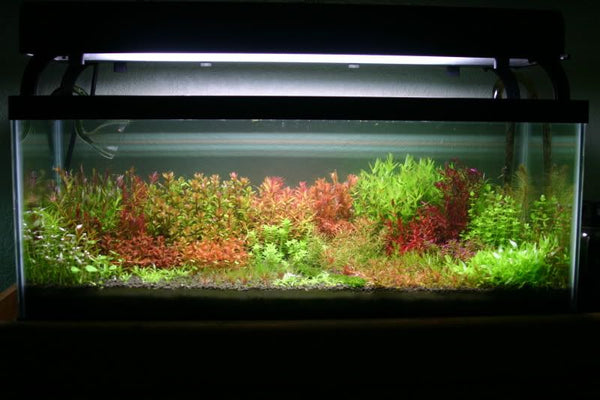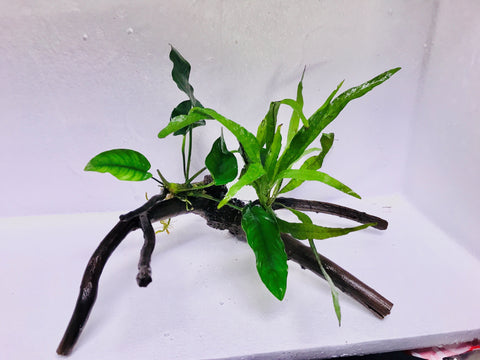Sold Out
Cryptocoryne wendtii EMERSED/POTTED
For Wholesale pricing please click on loginThis product is unavailable
Description: Native to the island of Sri Lanka, Cryptocoryne wendtii is one of the most common and widely used aquarium plants available today. It is also one of the most variable species, with several color variations including reds, browns, greens, and several mixes of those. To add to the variety, the texture of the leaves can vary greatly within the species, as can the leaf size, ranging from 5 to 18 inches.
It can also be one of the easiest plants to grow and cultivate, even if it does have some finicky moments. Cryptocoryne wendtii can tolerate low light or high light, and seems to respond with longer foliage in lower light conditions. While it responds to CO2 injection, it will grow perfectly fine without it. The plant only requires stable conditions and some time to adjust after being introduced into a new setting.
Use in Aquascaping: This variably sized Cryptocoryne can be used as a foreground plant in larger tanks with good light, assuming a variety is chosen that tends not to grow too large (such as the green varieties), or as a nice focal point in the midground of moderately sized aquariums. In smaller tanks it can be used as a distinct background plant where its leaves may reach the top and bend over to float along the water’s surface.
Its rosette growth form provides contrast to clumps of stem plants and can be used to separate the aquascape into well-defined groups or sections. The aquascaper can also take advantage of this growth form by using it to hide the bottom portions of stem plants, as stem plants tend to shed the leaves on the lower portions of the stem because they are deprived of light.
A well-planned grouping of Cryptocoryne wendtii can be used to make an attractive focal point or to draw focus to an adjacent area of interest. The wide variety of color and texture forms available within this species gives the aquarist a vast array of choices that will best suit the intended use.
Propagation: Cryptocoryne wendtii can be very easy to propagate. The grower only needs a portion of root with a living node to grow a new plant. However, growth is generally slow and it can take several months to have a full-sized plant develop.
Most growers will pull up a larger plant and split it apart into clumps of smaller plantlets. These are simply replanted a few inches apart to allow for some growing room. It also reproduces via runners, or rhizomes, that develop from the roots. In nature it also reproduces from seed. There are many hobbyists who grow these Cryptocoryne emersed, trying to mimic their natural environment and to encourage the development of interesting and beautiful flower structures.
Notes: Many hobbyists who first get Cryptocoryne wendtii into their aquariums will see a sudden deterioration in the plant and may think they have somehow killed it, even while other plants are thriving. It is important to keep in mind that these plants, while easy to maintain and grow once established, are finicky about changing conditions. Any sudden or drastic change in their surroundings can trigger this mysterious crypt melt. While the plants may seem to have suddenly died, a little patience by the hobbyist will shortly be rewarded by new leaves coming up from the otherwise healthy plant’s roots.
It can also be one of the easiest plants to grow and cultivate, even if it does have some finicky moments. Cryptocoryne wendtii can tolerate low light or high light, and seems to respond with longer foliage in lower light conditions. While it responds to CO2 injection, it will grow perfectly fine without it. The plant only requires stable conditions and some time to adjust after being introduced into a new setting.
Use in Aquascaping: This variably sized Cryptocoryne can be used as a foreground plant in larger tanks with good light, assuming a variety is chosen that tends not to grow too large (such as the green varieties), or as a nice focal point in the midground of moderately sized aquariums. In smaller tanks it can be used as a distinct background plant where its leaves may reach the top and bend over to float along the water’s surface.
Its rosette growth form provides contrast to clumps of stem plants and can be used to separate the aquascape into well-defined groups or sections. The aquascaper can also take advantage of this growth form by using it to hide the bottom portions of stem plants, as stem plants tend to shed the leaves on the lower portions of the stem because they are deprived of light.
A well-planned grouping of Cryptocoryne wendtii can be used to make an attractive focal point or to draw focus to an adjacent area of interest. The wide variety of color and texture forms available within this species gives the aquarist a vast array of choices that will best suit the intended use.
Propagation: Cryptocoryne wendtii can be very easy to propagate. The grower only needs a portion of root with a living node to grow a new plant. However, growth is generally slow and it can take several months to have a full-sized plant develop.
Most growers will pull up a larger plant and split it apart into clumps of smaller plantlets. These are simply replanted a few inches apart to allow for some growing room. It also reproduces via runners, or rhizomes, that develop from the roots. In nature it also reproduces from seed. There are many hobbyists who grow these Cryptocoryne emersed, trying to mimic their natural environment and to encourage the development of interesting and beautiful flower structures.
Notes: Many hobbyists who first get Cryptocoryne wendtii into their aquariums will see a sudden deterioration in the plant and may think they have somehow killed it, even while other plants are thriving. It is important to keep in mind that these plants, while easy to maintain and grow once established, are finicky about changing conditions. Any sudden or drastic change in their surroundings can trigger this mysterious crypt melt. While the plants may seem to have suddenly died, a little patience by the hobbyist will shortly be rewarded by new leaves coming up from the otherwise healthy plant’s roots.













